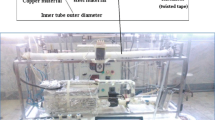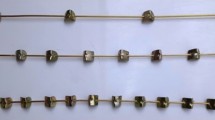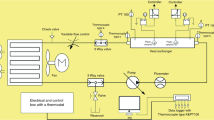Abstract
This study investigated the numerical analysis of Nusselt number and entropy generation of copper/water nano-fluid under turbulent flow conditions at volume fraction ranges of 1–5% within a helical coil under constant heat flux. The nano-fluid behavior was modeled through a single-phase model. Flow and heat transfer governing equations were discretized using finite volume method, and the SIMPLE algorithm was used to solve pressure-velocity coupling equations. The turbulence modelling was done by k-ε turbulence model in ANSYS FLUENT 15. Then, the examination and prediction of the resulted data were carried out using perceptron and radial basis function networks. The innovation of the present study was the application of an unsupervised method (namely, SOM) to specify the winner neuron. Input data of the artificial network included Reynolds number, input temperature, constant heat flux, nano-fluid thermal conductivity coefficient and nano-fluid volume fraction, while output parameters included Nusselt number and total entropy generation. The results showed that Nusselt number, entropy generation yielded from heat transfer, and friction increased as the Reynolds number increased. With an increase in the volume fraction, entropy generation yielded from heat transfer and friction decreased and increased, respectively. The results of artificial networks revealed that self-organizing map (SOM) model had 25 neurons, possessing the highest amount of data. Moreover, Mean Squared Error (MSE), correlation coefficient, and maximum error, Nusselt number and total entropy generation for perceptron neural network were 5.0103,0.996,9.1865, 4.389 × 10−5, and 0.998,0.0259, respectively, confirming a successful prediction. In addition to radial basis function networks, the values of Mean Squared Error (MSE), Root Mean Squared Error (RMSE), standard deviation(σ) and a kind of Error(μ) for Nusselt number and entropy generation total were 8.2255 × 10−8,0.0002868,0.00028718,4.741 × 10−6 and 6.0157 × 10−8,0.00024527,0.00024549,7.9006 × 10−6, respectively.








































Similar content being viewed by others
References
Aghayari R, Maddah H, Ashori F, Hakiminejad A, Aghili M (2015) Effect of nanoparticles on heat transfer in mini double-pipe heat exchangers in turbulent flow. Heat Mass Transf 51(3):301–306
Maddah H, Aghayari R, Mirzaee M, Ahmadi MH, Sadeghzadeh M, Chamkha AJ (2018) Factorial experimental design for the thermal performance of a double pipe heat exchanger using Al2O3-TiO2 hybrid nanofluid. International Communications in Heat and Mass Transfer 97:92–102
Maddah H, Ghasemi N, Keyvani B, Cheraghali R (2017) Experimental and numerical study of nanofluid in heat exchanger fitted by modified twisted tape: exergy analysis and ANN prediction model. Heat Mass Transf 53(4):1413–1423
Ghasemi N, Aghayari R, Maddah H (2018) Optimizing the parameters of heat transmission in a small heat exchanger with spiral tapes cut as triangles and Aluminum oxide nanofluid using central composite design method. Heat Mass Transf 54(7):2113–2130
Majidi D, Alighardashi H, Farhadi F (2018) Experimental studies of heat transfer of air in a double-pipe helical heat exchanger. Appl Therm Eng 133:276–282
Datta AK, Yanase S, Kouchi T, Shatat MM (2017) Laminar forced convective heat transfer in helical pipe flow. Int J Therm Sci 120:41–49
Abou-Ziyan HZ, Helali AHB, Selim MY (2016) Enhancement of forced convection in wide cylindrical annular channel using rotating inner pipe with interrupted helical fins. Int J Heat Mass Transf 95:996–1007
Fuskele V, Sarviya RM (2019) Heat transfer enhancement in a circular tube fitted with twisted tape having continuous cut edges using CuO-water nanofluid in green buildings and sustainable engineering. Springer, Singapore, pp 367–383
Jafaryar M, Sheikholeslami M, Li Z, Moradi R (2018) Nanofluid turbulent flow in a pipe under the effect of twisted tape with alternate axis. J Therm Anal Calorim:1–19
Mohammadiun H, Mohammadiun M, Hazbehian M, Maddah H (2016) Experimental study of ethylene glycol-based Al2O3 nanofluid turbulent heat transfer enhancement in the corrugated tube with twisted tapes. Heat Mass Transf 52(1):141–151
Maddah H, Ghasemi N (2017) Experimental evaluation of heat transfer efficiency of nanofluid in a double pipe heat exchanger and prediction of experimental results using artificial neural networks. Heat Mass Transf 53(12):3459–3472
Salem MR, Eltoukhey MB, Ali RK, Elshazly KM (2018) Experimental investigation on the hydrothermal performance of a double-pipe heat exchanger using helical tape insert. Int J Therm Sci 124:496–507
Shoghl SN, Loloei Z, Moraveji MK (2018) Three-dimensional multiphase CFD modeling of thermal–hydraulic characteristics of nanofluid flow in helical microchannels. J Therm Anal Calorim:1–16
Zare M, Heyhat MM (2018) Performance evaluation of nanofluid flow in conical and helical coiled tubes. J Therm Anal Calorim:1–12
Khosravi Bizhaem H, Abbassi A (2017) Numerical study on heat transfer and entropy generation of developing laminar nanofluid flow in helical tube using two-phase mixture model. Adv Powder Technol 28(9):2110–2125
Darbari B, Rashidi S, Abolfazli Esfahani J (2016) Sensitivity analysis of entropy generation in Nanofluid flow inside a channel by response surface methodology. Entropy 52:1–16
Najafabadi H, Keshavarz Moraveji M (2016) Three-dimensional CFD modeling of fluid flow and heat transfer characteristics of Al2O3/water nanofluid in microchannel heat sink with Eulerian-Eulerian approach. Iranian Journal of Chemical Engineering 13(4):46–61
Aghayari R, Maddah H, Ahmadi MH, Yan W, Ghasemi N (2018) Measurement and artificial neural network Modeling of electrical conductivity of CuO/glycerol Nanofluids at various thermal and concentration conditions. Energies 11:1–16
Safari A, Saffar-Avval M, Amani E (2018) Numerical investigation of turbulent forced convection flow of nano fluid in curved and helical pipe using four-equation model. Powder Technol 328:47–53
Bahrehmand S, Abbassi A (2016) Heat transfer and performance analysis of nanofluid flow in helically coiled tube heat exchangers. Chem Eng Res Des 109:628–637
Khabir H, Motallebzadeh R (2018) A numerical study on heat transfer of the nanofluid flow inside helical tube through the two-phase method. Part Sci Technol 36(1):84–90
Sharma SK, Gupta SM, Kumar A (2017) Hydrodynamic studies of CNT nanofluids in helical coil heat exchanger. Materials Research Express 4(12):124002
Naphon P, Wiriyasart S, Arisariyawong T, Nakharintr L (2019) ANN, numerical and experimental analysis on the jet impingement nanofluids flow and heat transfer characteristics in the micro-channel heat sink. Int J Heat Mass Transf 131:329–340
Wang M, Zheng M, Chao M, Yu J, Zhang X, Tian L (2019) Experimental and CFD estimation of single-phase heat transfer in helically coiled tubes. Prog Nucl Energy 112:185–190
Izadi M, Rahimi M, Beigzadeh R (2019) Evaluation of micromixing in helically coiled microreactors using artificial intelligence approaches. Chem Eng J 356:570–579
Pak BC, Cho YI (1998) Hydrodynamic and heat transfer study of dispersed fluids with submicron metallic oxide particles. Experimental Heat Transfer an International Journal 11(2):151–170
Maiga SEB, Palm SJ, Nguyen CT, Roy G, Galanis N (2005) Heat transfer enhancement by using nanofluids in forced convection flows. Int J Heat Fluid Flow 26(4):530–546
Maxwell JC (1881) A Treatise on electricity and magnetism. Clarendon press, Oxford
Zamzamian A (2014) Entropy generation analysis of EG–Al2O3 nanofluid flows through a helical pipe. International Journal of Nanoscience and Nanotechnology 10(2):103–110
Ghasemi N, Aghayari R, Maddah H (2018) Designing an artificial neural network using radial basis function to model exergetic efficiency of nanofluids in mini double pipe heat exchanger. Heat Mass Transf 54(6):1707–1719
Maddah H, Aghayari R, Ahmadi MH, Rahimzadeh M, Ghasemi N (2018) Prediction and modeling of MWCNT/carbon (60/40)/SAE 10 W 40/SAE 85 W 90 (50/50) nanofluid viscosity using artificial neural network (ANN) and self-organizing map (SOM). J Therm Anal Calorim 134:1–12
Ardekani AM, Kalantar V, Heyhat MM (2019) Experimental study on heat transfer enhancement of nanofluid flow through helical tubes. Adv Powder Technol 30(9):1815–1822
Author information
Authors and Affiliations
Corresponding author
Additional information
Publisher’s note
Springer Nature remains neutral with regard to jurisdictional claims in published maps and institutional affiliations.
Rights and permissions
About this article
Cite this article
Aghayari, R., Rohani, S., Ghasemi, N. et al. Numerical investigation of heat transfer in a helically coiled tube using copper/water nano-fluid under constant heat flux and prediction of the results using perceptron and radial basis function networks. Heat Mass Transfer 56, 1051–1075 (2020). https://doi.org/10.1007/s00231-019-02758-z
Received:
Accepted:
Published:
Issue Date:
DOI: https://doi.org/10.1007/s00231-019-02758-z




